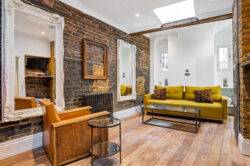Debby Lee’s grade II-listed five-story four bedroom home come commercial space pays homage to her legendary club days (Picture:
Debby Lee’s Grade II-listed, five-storey, four-bedroom home on Leather Lane, near London’s hip Clerkenwell district, might date back to the Georgian era, but to her and her friends it has always been ‘the house that house built’.
If you can lay claim to any kind of clubbing cred, you’ll know her name is a legendary one.
A self-confessed wild child who was hitting dance floors from the age of 13, Debby started her career in music as a club promoter at the London Astoria in the mid-1980s, and helped run gay club BANG!, later known as the iconic G-A-Y.
At the dawn of the 1990s, as electronic dance music took over the world, Debby launched the UK’s first legal rave venue, Bagley’s, in a vast warehouse in King’s Cross, and, in 2001 brought over superclub Pacha from Ibiza, with Billy Reilly of The Cross.
Reilly’s venue in York Way, N1, made dance music history with residencies by DJs such as Danny Rampling and Judge Jules. Pacha, of course, went on to become the most famous clubbing brand in history.
‘So it was really house music that gave me the opportunity to buy the home,’ says Debby, who is now a writer, filmmaker and executive producer in TV.
‘I bought it in 1998 when I was 31 for £165,000, when it was being used as a deli, with the family living above the shop, and I completely renovated it from top to bottom – even though I had no experience in DIY.
More: Trending
‘I was extremely lucky in that I had a lot of industry friends who knew builders who could kit out club spaces really quickly, so they came and helped me out when they could.’
This was how the very fabric of legendary venues ended up being woven into the home. Flooring reclaimed at the Café de Paris on Leicester Square ended up in Debby’s kitchen, with granite worktops taken from Pacha London and many radiators from The Cross.
The standout typographic artworks created to advertise Pacha are now rare collectors’ items (Picture: Savills)
Debby Lee says it was House music that allowed her to buy a Grade II-listed house on Leather Lane in Clerkenwell in 1998 (Picture: Savills)
Debby set about reconfiguring the 3,100sq ft of space to make it the perfect blend of private home, commercial space and rentable apartment (Picture: Savills)
Flooring reclaimed at the Café de Paris on Leicester Square ended up in Debby’s kitchen (Picture: Savills)
Truly putting her own spin on things, then, Debby has created an epic live-work space that was also the perfect venue for after-parties.
Guests over the years have included Kylie, Boy George, Joaquin Phoenix, the late Paul O’Grady, and Paul Oakenfold, the latter a close friend with whom Debby is collaborating on writing a West End show about 1990s London clubland, set to open next year.
Debby spent her early years living in her family’s crumbling, 13-room period house in inner-city Hackney, with no central heating, before moving to Woodford, on the outskirts of Essex.
With the county the epicentre of the jazz funk and soul scene in the 1970s and 1980s, Debby then progressed to West End clubs at the age of 16. ‘I lived for my music from a really young age,’ Debby says. ‘I always wanted the bright lights and big city.’
Aged 18, while working at the London Astoria, she was offered the chance to buy a flat on Greek Street in Soho for £11,000. ‘My parents forbade me, saying it was too seedy an area,’ she laughs, ‘so I ended up renting in Clerkenwell.’
Debby had come to know and love Leather Lane, EC1 – between Clerkenwell and Holborn, it’s the London Borough of Camden’s oldest street market – for its fruit and veg stalls, historic pubs, quirky clothes and record outlets. ‘It reminded me of the edgy vibe of the Lower East Side of New York,’ she says.
Debby discovered fireplaces and beautifully crafted hearths hidden in the 1950s and 1960s (Picture: Savills)
Debby’s house is probably one of the last of the former merchant’s homes on the street not completely split up into flats (Picture: Savills)
Many of Debby’s radiators come from legendary nightclub ‘The Cross’ (Picture: Savills)
The original fireplace feature was uncovered in the bathroom (Picture: Savills)
A traditional delicatessen that had been run by the same family since 1890 also became a favourite go-to destination, with Debby becoming good friends with the owners. This would be the property she would eventually buy, ‘although they couldn’t believe I could actually afford it, as I always wore clothes with rips and holes in, which was rave scene fashion at the time,’ Debby laughs.
Over the centuries, the freehold terraced building had been used as an apothecary’s, a cobbler’s and a dairy – cattle were kept at the back of the house when there were still fields surrounding this part of London – with its original cellaring still reached by trapdoor. Many of the original Georgian features that gave it such good architectural bones remained, such as high ceilings and sash windows, but many were hidden – covered up by paint and plasterboard, as was the trend in the 1950s and 1960s.
‘I discovered some absolutely amazing things along the way, including all the fireplaces and some beautifully crafted hearths,’ Debby says.
‘Underneath plasterboard we found 18th-century panelling and even a cabinet designed to store top hats. Some of the brickwork revealed small hand and fingerprints, evidence of the child labour at the time. That was an incredibly emotional find.’
Having uncovered and restored original features, Debby set about reconfiguring the 3,100sq ft of space to make it the perfect blend of private home, commercial space and rentable apartment.
On the ground floor, she lets the commercial premises, with a one-bedroom rental apartment at the rear, also spanning the lower-ground floor.
Debby added lush floral-patterned William Morris wallpaper to the staircase panelling 21 years ago (Picture: Savills)
Amongst her most-treasured objects are things found on her global travels, including artwork from Thailand and Turkish kilims (Picture: Savills)
She is as happy to shop at Heal’s, H&M and flea markets (Picture: Savills)
Debby’s bedrooms are a mix of Georgian elegance and stripped down wooden flooring (Picture: Savills)
Her own retreat is over the first, second and third floors, with three double bedrooms and a fabulous roof terrace taking in skyline views – perfect for a sundowner. It’s a moreish mix of classic Georgian elegance, stripped wooden flooring and unconventional furniture and décor. As you’d imagine, Debby isn’t one to pigeonhole her interiors style. ‘I can only say it’s eclectic,’ she says.
‘Some of my favourite hunting grounds are The Criterion auction house on Essex Road, in Islington, N1, and I absolutely love flea markets. Though I am also as happy to do Heal’s or H&M.’
Debby was certainly ahead of the curve when she decided to introduce lush floral-patterned William Morris wallpaper to the staircase panelling 21 years ago – it still looks incredibly fresh and contemporary.
Many of her most-treasured objects are things found on her global travels, including artwork from Thailand and Turkish kilims, mixed up with sculptural pieces by Philippe Starck.
Amid black and white photography, the standout typographic artworks created to advertise Pacha are now rare collectors’ items.
‘There has been a lot of love poured into this house,’ says Debby, who has also raised a daughter here, ‘and there’s definitely nothing cookie cutter about it.
On the ground floor, she lets the commercial premises (Picture: Savills)
Debby’s roof terrace taking in skyline views (Picture: Savills)
Debby Lee with Billy Reilly who introduced the Ibiza superclub Pacha to London in 2001 (Picture: Owner supplied)
‘I have had so many years of happiness here – it feels like a really lucky house.’ Debby, however, says she is ready to change things up a bit, and while her clubbing days aren’t completely relegated to the past, is ready to embark on a new adventure.
She has put her home on the market for £2.85million and is planning a move to England’s south coast, to focus on her writing. ‘I would absolutely love to buy a house in Ibiza,’ she says, ‘but house prices there rival London’s. I’m going to buy a house by the sea and keep a pied-a-terre in the capital.’
This will only be the second time in more than 120 years this Leather Lane house will have been on the sales market – and is probably one of the last of the former merchant’s homes on the street not completely split up into flats.
The street has changed a lot since Debby first moved in – the historic market place is now a thriving centre for multicultural and veggie cuisine and artisan cafes.
‘It’s been gentrified a lot, but retains its incredible buzz,’ Debby says, ‘and you couldn’t get a better lifestyle in London, so close to both Shoreditch and Soho.
‘It hasn’t just been a house, but a way of life. Buying this house was the best thing I could have ever done.’
MORE : Manchester two-bed on sale for £160,000 features bizarre extra addition
MORE : Abandoned school left untouched more than 50 years with textbooks still inside
Including flooring reclaimed from the Café de Paris and granite worktops from Pacha.





